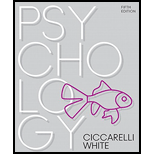
Introduction:
A personality disorder does not influence a person’s life, and however, it affects adjustment of the entire life of a person. In personality disorder, a person adopts rigid, persistent and maladaptive patterns of behaviors which interfere with general social interactions. According to the DSM-5 lists, there are 10 primary types of these disorders come under three categories: people in the first category are seen as eccentric or odd with others, people in the second category behave very dramatically, emotional or erratically and people in the third category have anxiety or fearfulness is present as the main emotion. All three categories can be labeled as Cluster A, Cluster B, and Cluster C.
Want to see the full answer?
Check out a sample textbook solution
Chapter 14 Solutions
Psychology Plus MyLab Psychology -- Access Card Package (5th Edition) (Ciccarelli & White Psychology Series)
- Match the term with the short description. Prompts Answers Recitative A composition or movement inserted between parts of a longer composition Aria A speech-like style of singing Overture A short instrumental introduction to a larger work Interlude A song for solo voice with orchestra that showcases vocal virtuosityarrow_forwardThe composer/conductor who double orchestra musicians’ salaries and treated them with respect was: a) Joseph Haydn b) Felix Mendelssohn c) Ludwig van Beethoven d) Richard Wagnerarrow_forwardMatch the term with its short description. Prompts Answers Concerto The full orchestra or a large group of musicians contrasted with a smaller one Concerto grosso Composition for several instrumental soloists and small orchestra; usually in three movements Fugue A polyphonic composition based on one main theme or subject treated in counterpoint Tutti Extended composition for instrumental soloist and orchestra; usually in three movementsarrow_forward
- Match the term with the short description. Prompts Answers Coda Is section displaying technical virtuosity that is played or improvised by the soloist without orchestral accompaniment Exposition A concluding section that rounds off a movement by extending the tonic chord Cadenza The first section of a sonata form Pedal A single tone, often in the bass, that is held while other voices produce changing harmonies against itarrow_forwardThe first examples of polyphony are believed to be originated between 700-900 C.E. - when French nobles composed love songs for court festivities - in Northern Italy - when musicians composed new songs to accompany dances - in the Notre Dame cathedral in Parisarrow_forwardDuring the Renaissance, it was common practice for noble families to bring their musicians along when traveling from one castle to another. a) True b) Falsearrow_forward
- In the Middle Ages _____ were the center of learning and music making. - crusades - castles - schools - churchesarrow_forwardWhat sentences best describe the troubadours of the Middle Ages? (Mark all that apply) - Performed music and acrobatics in castles, taverns, and town squares - Composed songs on love and honor - Belong to the lowest social classes - Distributed news and gossip from town to townarrow_forwardSelect all the predominant types of composition in the Renaissance period: (Mark all that apply) - the mass - motets - madrigals - symphoniesarrow_forward
- Select items that make a cantata and an opera different. - use of scenery and costumes - acting - length of the composition - use of vocal soloistsarrow_forwardDuring the Renaissance period, many musicians found employment in: a) Churches b) Schools c) Royal Courts d) Regional orchestrasarrow_forward_________ ‘s piano style was characterized by a poetic use of the pedal, singing melodies, and the use of rubato. a) Robert Schumann b) Franz Liszt c) Frédéric Chopin d) Johannes Brahmsarrow_forward
 Ciccarelli: Psychology_5 (5th Edition)PsychologyISBN:9780134477961Author:Saundra K. Ciccarelli, J. Noland WhitePublisher:PEARSON
Ciccarelli: Psychology_5 (5th Edition)PsychologyISBN:9780134477961Author:Saundra K. Ciccarelli, J. Noland WhitePublisher:PEARSON Cognitive PsychologyPsychologyISBN:9781337408271Author:Goldstein, E. Bruce.Publisher:Cengage Learning,
Cognitive PsychologyPsychologyISBN:9781337408271Author:Goldstein, E. Bruce.Publisher:Cengage Learning, Introduction to Psychology: Gateways to Mind and ...PsychologyISBN:9781337565691Author:Dennis Coon, John O. Mitterer, Tanya S. MartiniPublisher:Cengage Learning
Introduction to Psychology: Gateways to Mind and ...PsychologyISBN:9781337565691Author:Dennis Coon, John O. Mitterer, Tanya S. MartiniPublisher:Cengage Learning Psychology in Your Life (Second Edition)PsychologyISBN:9780393265156Author:Sarah Grison, Michael GazzanigaPublisher:W. W. Norton & Company
Psychology in Your Life (Second Edition)PsychologyISBN:9780393265156Author:Sarah Grison, Michael GazzanigaPublisher:W. W. Norton & Company Cognitive Psychology: Connecting Mind, Research a...PsychologyISBN:9781285763880Author:E. Bruce GoldsteinPublisher:Cengage Learning
Cognitive Psychology: Connecting Mind, Research a...PsychologyISBN:9781285763880Author:E. Bruce GoldsteinPublisher:Cengage Learning Theories of Personality (MindTap Course List)PsychologyISBN:9781305652958Author:Duane P. Schultz, Sydney Ellen SchultzPublisher:Cengage Learning
Theories of Personality (MindTap Course List)PsychologyISBN:9781305652958Author:Duane P. Schultz, Sydney Ellen SchultzPublisher:Cengage Learning





